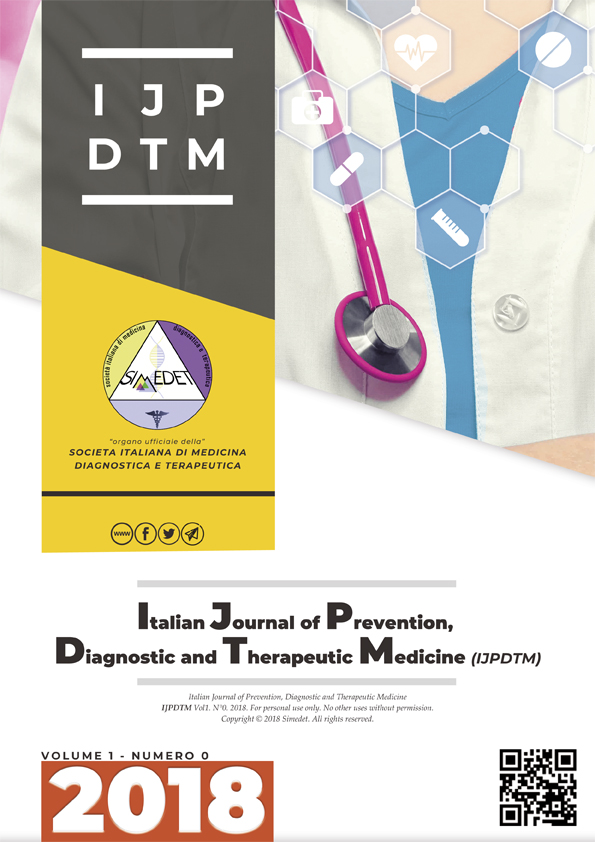Fecal incontinence management in an intensive care unit
Main Article Content
Abstract
Faecal incontinence (IF) is the inability to control the leakage of solid or liquid stools during exercise or normal daily activity. IFA (acute faecal incontinence) is present in more than 40% of patients admitted to intensive care units. IFA represents a recognized risk factor for the transmission of nosocomial infections such as Clostridium difficile, in the formation of skin lesions in the perianal area, with increased morbidity, mortality, time and costs of hospitalization.
The specific Management on incontinence represents an important chapter in the overall management of the acute and critical patient in intensive care. It requires a multidisciplinary and multi-professional approach to assess the causes and severity of the IF, and avoid or minimize complications. The nurse, within the care team, is an essential resource in the care of the incontinent patient and the family members. . The awareness of the problem, the adoption of the recommendations, the use of management tools of the AFID, represent the first step for a correct management.
Downloads
Article Details

This work is licensed under a Creative Commons Attribution-NonCommercial-NoDerivatives 4.0 International License.
References
Binks R, Luca E De, Dierkes C, Franci A, Gallart E, Niederalt G, et al. Intensive Care Society Expert recommendations for managing acute faecal incontinence with diarrhoea. J Intensive Care Soc. 2013;14(Supplement 2):1–9.
Mike langill, BScN (Kin), RN; Songkai Yan, MS; Dheerendra Kommala, MD; Michael Michenko, BsCn R. Fecal management system budget impact analysis. 2012;58(12):25–33.
Lehur PA, Leroi AM, Une D, Adulte IADEL. Incontinence anale de l’adulte : recommandations pour la pratique clinique. Ann Chir. 2000;125(6):511–21.
Bliss DZ, Norton CA, Miller J, Krissovich M. Directions for future nursing research on fecal incontinence. Nurs Res [Internet]. [cited 2017 Jan 2];53(6 Suppl):S15-21.
Rao SS. Pathophysiology of adult fecal incontinence. Gastroenterology . 2004 Jan 1 ;126:S14–22.
Vaizey CJ, Carapeti E, Cahill JA, Kamm MA. Prospective comparison of faecal incontinence grading systems. Gut . 1999 Jan 1 ;44(1):77–80.
Jorge JM, Wexner SD. Etiology and management of fecal incontinence. Dis Colon Rectum. 1993 Jan ;36(1):77–97.
Linee guida SINPE per la Nutrizione Artificiale Ospedaliera 2002.
Cinzia IM, Dina A, Giuliana B, Quesito CS. Prove di efficacia nella gestione delle linee per l’alimentazione enterale.
Fink MP, Abraham E, Vincent J-L, Kochanek PM. Terapia intensiva. London : Elsevier Health Sciences Italy; 2007. 2352 p.
Barbut F, Petit JC. Epidemiology of Clostridium difficile-associated infections. Clin Microbiol Infect. 2001 Aug;7(8):405–10.
Serra R, Rigobello V, Curti MLuisa Moro C, Cusano C, Lobati P, Martini L, et al. Prevenzione e controllo delle infezioni da Clostridium difficile. 2009;16(1).
Faecal incontinence in adults: management | 1-guidance | Guidance and guidelines | NICE. NICE;
Vanzetta C. eventi avversi nell’utilizzo di panoloni e di guaine urinarie in soggetti incontinenti; revisione della letteratura. Sci Inferm. 2011;48(1):27–36.
Reintam Blaser A, Starkopf L, Deane AM, Poeze M, Starkopf J. Comparison of different definitions of feeding intolerance: A retrospective observational study. Clin Nutr. 2015 Oct;34(5):956–61.
Runeman B. Skin interaction with absorbent hygiene products. Clin Dermatol. 2008 Jan;26(1):45–51.
Beitz JM. Fecal incontinence in acutely and critically ill patients: options in management. Ostomy Wound Manage. 2006 Dec ;52(12):56–8, 60, 62–6.
Luca D, Soc IC. Raccomandazioni di esperti per la gestione dell' incontinenza fecale con diarrea nei reparti di terapia intensiva L ' IFA ( incontinenza fecale acuta ). 2013;
Rao SSC. Advances in Diagnostic Assessment of Fecal Incontinence and Dyssynergic Defecation. YJCGH. 8:910–919.e2.
di T. H. Herdman SK. Diagnosi infermieristiche: definizioni e classificazione. Nanda international. 6th ed. CEA, editor. 2015 . 496 p
Johnson M, Moorhead S, Bulechek G, Butcher H, Maas M, Swanson E. Collegamenti NANDA-I con NOC e NIC..
Bulechek GM, Butcher H., Dochterman J., Wagner C. Classificazione NIC degli interventi infermieristici. Casa editrice Ambrosiana, editor. 2013. 815 p.
Ambrosino P, Ballerini G, Elia M, Giannini A, Molon A, Scalini D, et al. gestione delle feci liquide e semi-liquide nei pazienti critici:sviluppo di uno strumento di misurazione. 2008;5.

